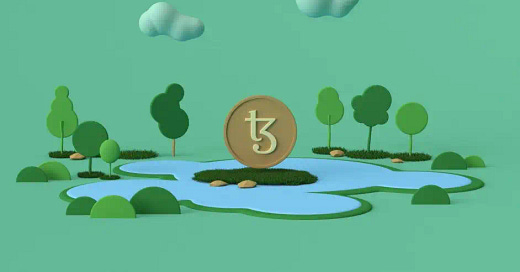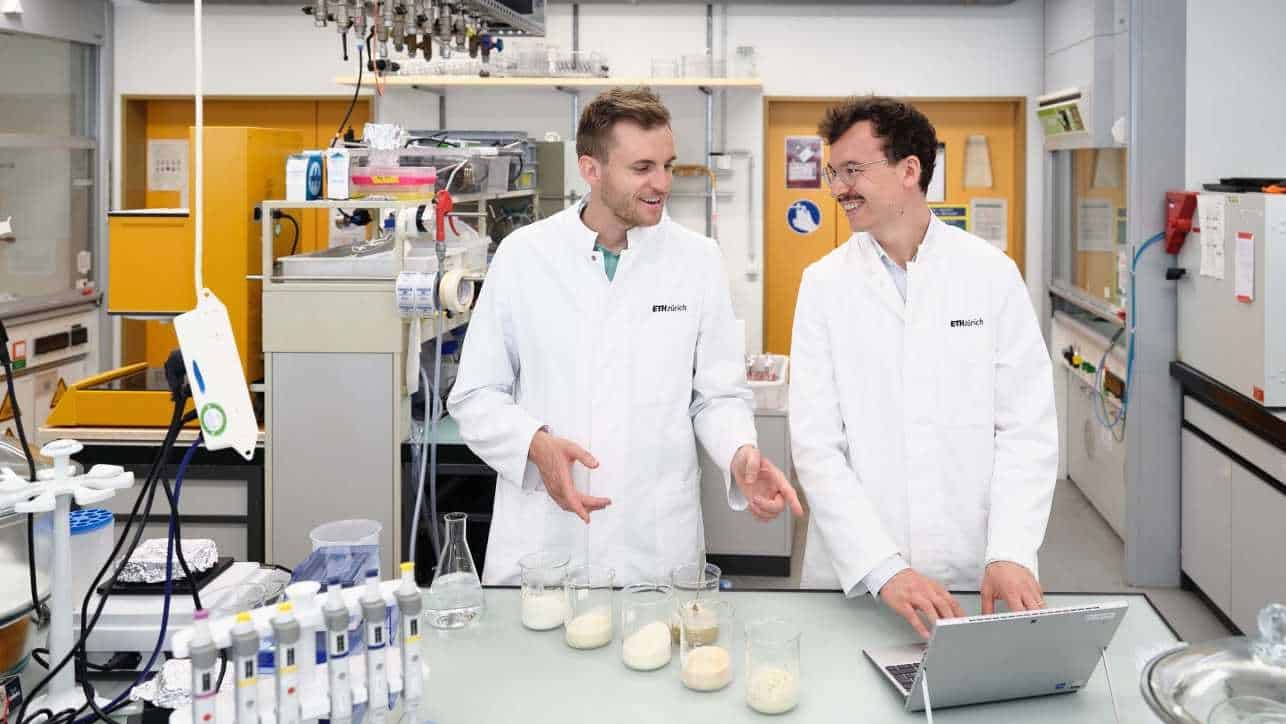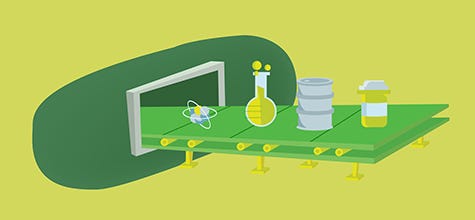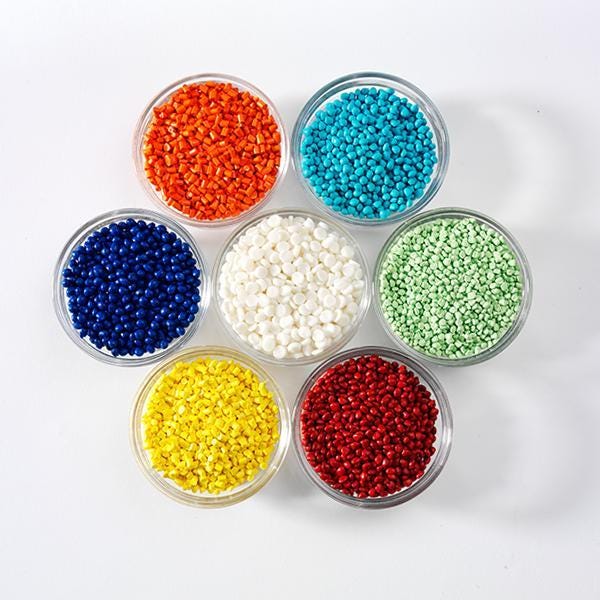👨💻Mixing blockchain with microalgae?
PLUS Novak Djokovic discusses his algae-based diet, making biopolymers from cyanobacteria and Spirulina for the World
"Don’t give up. This road won’t be easy, so you must go out there and fight every day." — Marina Garcia, Spirulina Source
Dear algae technologists - hello and welcome to The Paxtier Report!
To start the email this week, meet Lukas Böcker and Severin Eder, a duo from ETH Zurich who have put their own twist on alternative proteins - algae-based prawns.
These guys turned to microalgae as part of their joint Pioneer Fellowship project, and by combining the organism with soy and pea extracts, they hope to bring more sustainability to the seafood industry.
Find out more HERE.
In today’s report:
Markets: 👨💻Mixing blockchain with algae?
Deals: 🤝Lgem and Synalgae merge
Epic: 🧪Making biopolymers from cyanobacteria
Fireside Chats: 🟢Spirulina for the World and Marina Garcia
Around the web: 🎾Novak Djokovic discusses his algae-based diet.
Markets and Investing
👨💻 Mixing blockchain with algae?
This week, Globacap announced the release of the “world’s first blockchain-based algae biomass project.”
The project hopes to support the development, construction, and operation of algae biomass farms - and Sustainable Impact Token are the brains behind the operation.
What’s the plan?
SIT’s algae biomass farms will run on renewable energy and produce high quality microalgae. The fundraising round will see investors receive blockchain tokens, representing their preferred shares in the project, and any carbon credits generated by the process will also be tokenized into an Algaecoin.
Here’s what Chairman & Founder of Sustainable Impact Token, Peter Henderson, had to say:
Our vision is to play our part in addressing some of the real challenges of our time – how can the growing world population be fed sufficiently, nutritiously and can this ambition be achieved in a way that improves, rather than harms, the environment? We believe our approach helps on all these fronts and know that the investor community is keen to join us on the journey.
SIT presents a unique investment opportunity that is underpinned by our three core pillars: food security, renewable energy and carbon reduction.
We wanted to structure the offering using an innovative, transparent and secure approach. Investors are being offered an attractive return, in a real asset, but through digital technology – and they can make their investments through fiat or crypto currencies.
Bringing the token offering to market has been amazingly smooth, which is a credit to our partners at Globacap, Tezos and Lumin Capital.
✂️Algae Market Snippets
Some other big moves this week:
DIC Invests in US Sustainable Biotech Startup Back of the Yards Algae Sciences. BYAS owns proprietary technology for efficiently extracting active ingredients from biobased materials, notably algae and mycelia. The team currently produces unique products such as food colorants, food additives, biostimulants, and their spirulina (cyanobacteria) algae-based Heme Analog (BYAS-AHA) is receiving intense interest for its ability to enhance the alternative meat taste and aroma, without the use of genetically modified organisms (GMO). (Read more HERE.)
BettaF!sh to Launch TU-NAH Spreads in Five European Countries: "BettaF!sh products are made with fava beans, making them soy-free. They also contain European seaweed, which is said to provide an authentic fish-like taste while improving sustainability (since neither land nor fresh water is required to cultivate it).
In less than a year, our team of product developers was able to create a delicious, vegan alternative to tuna that is helping us push the topic of saving our seas and their dwellers to the forefront.” (Read more HERE).
Momentum grows in development of new global ocean finance ecosystem: The Ocean Risk and Resilience Action Alliance (ORRAA) is hoping to channel significant investment into coastal and ocean natural capital. And The Sea Change Impact Financing Facility (SCIFF) aims to drive at least USD$1bn of investment into coastal and ocean ecosystems by 2030, a springboard from which to mobilise at least USD$2.5bn of broader finance capital into this space. (Read more HERE).
Cozumel City Council approves another 4.4 million pesos (USD$194,000) for sargassum removal. Loeza Pacheco says the city is focused on hiring more sargassum collection workers as well as the acquisition of safety equipment such as boots, caps and uniforms with sun and water protection. The money will also be used for the acquisition of a 3.5 ton capacity cargo vehicle to make cleaning time more efficient. According to official figures, Cozumel has collected a record 1137.09 tons of seaweed already this year. (Read more HERE).
The world’s first ‘methane-reduced’ beef is now at grocery stores. At the Swedish grocery chain, Coop, there’s now a new product that isn’t available anywhere else in the world: “low methane” beef. “This is the first time that low-methane beef is going out to consumers,” says Fredrik Åkerman, cofounder and CEO of Volta Greentech. The startup partnered with Coop and a new food company called Protos to bring the food to market in a pilot. (Read more HERE).
Lgem and Synalgae have joined forces and officially merged. The joint activities will continue to grow under the name Lgem, scaling their integrated solutions with brand-new photobioreactors and AlgaeHUB services. (Read more HERE).
Scidmore, Owings & Merrill’s (SOM) partnership with Prometheus Materials comes under the spotlight: “We’ve had clients come in and say they want it in their project right away,” SOM’s Brant Coletta told TIME. “It’s hard for me to hold my design teams back.” (Read more HERE)
The project AlgaeTex from the BIOTEXFUTURE innovation space was able to successfully produce knitted fabrics made from partially algae-based polymers. They plan to use these in high-quality sports textiles. (Read more HERE).
The Australian firm appointed to Murdoch’s US$200m ranch looks to asparagopsis: Impact Ag has two carbon projects in the pipeline on the Montana ranch – one sequestering soil carbon and another using asparagopsis seaweed in a grassfed system to reduce methane emissions. (Read more HERE.)
Major funding for project to regenerate Wellington’s underwater forests: This is the only project of its kind in New Zealand and has secured a substantial funding boost from Wellington-based Clare Foundation, in collaboration with existing partner the Wellington Community Fund, whose three-year funding commitment enabled the project to get off the ground in 2021. (Read more HERE).
In depth with Peter Green
📝Research Rundown: Making biopolymers from algae
THE BIG IDEA
Autotrophic microorganisms have attracted plenty of attention as sustainable/green production platforms.
This stems from their ability to use light, or an inorganic electron donor, to convert CO2 into biomass and potentially valuable products.
But how can we make more of these bioproducts? And which recent modifications allow us to create longer chain biopolymers from these little factories?
This week, Srisawat et al. set out to find the answers, and here’s our quick summary.
Metabolic Engineering
CO2 fixation developments
Under photoautotrophic conditions in cyanobacteria, bioproducts are synthesised via the Calvin–Benson–Bassham (CBB) cycle.
Unfortunately, this pathway is limited by one of the most inefficient enzymes found in nature, Rubisco, which scientists have tried to work around by:
Overexpressing CBB-related enzymes, which can significantly increase the CO2 fixation rate (See HERE),
Directly modifying the Rubisco enzyme (As seen in the direct evolution of the large subunit of Synechocystis sp. PCC 6803 Rubisco (RbcLF140I), which improved the photosynthesis rate by ~55%), and
Manipulating the cyanobacterial CO2 concentrating mechanism (CCM). For example, by introducing an additional bicarbonate transporter, which has been shown to double the total growth and biomass of a Synechocystis sp. PCC6803 culture.
Overall, these changes can certainly increase the final concentration of bioproducts…
… But how can we be more selective?
Specifically, how have teams optimised for biopolymers such as glycogen, hyaluronate, cyanophycin, and polyhydroxyalkanoates (PHA’s)?
Here are just a few suggestions:
Firstly, we can play with the right glycogen regulatory enzymes: For example, introducing a theophylline-responsive riboswitch can control the expression of ADP-glucose pyrophosphorylase, the rate-limiting step of glycogen biosynthesis, resulting in a 300% increase in glycogen accumulation.
Secondly, why not try overexpressing pha genes? The most common PHA polymer produced in cyanobacteria is poly[(R)-3 hydroxybutyrate] (PHB). By overexpressing endogenous pha genes for PHB biosynthesis using a high copy number vector in Synechocystis sp. PCC 6803, we can successfully enhance PHB production by up to 10.59 mg/L (7% of its biomass weight), and
Finally, we can use a mutant PII protein: For instance, cyanophycin is of particular interest in biotechnology as a source of polyaspartic acid, a biocompatible and biodegradable polymer used in several industries. Maximising the accumulation of cyanophycin in cyanobacteria was demonstrated in an engineered Synechocystis sp. PCC 6803 by replacing the PII protein with its mutated variant (PII(I86N)). This led to a 10x in arginine, allowing cyanophycin to reach up to 57.3% of the organism’s biomass.
Overall
Srisawat et al.’s review outlines several modifications that have benefitted the autotrophic biopolymer space, and I’d highly recommend the paper to anyone hoping to get an overview of the sector.
Unfortunately, it’s clear that this space is limited by production efficiency, and only time will tell whether this infant technology can make it on the big stage.
🐟 Community Fireside Chats: Spirulina for the World and Marina Garcia
This week, I sat down with Marina Garcia, a marine biologist and coastal zone expert based out of Costa Rica.
Marina currently works for Spirulina Source, where she researches Latin American microalgae companies, and supports the organising team behind the ‘Spirulina for the World’ conference.
Here’s a teaser from our recent chat, which explored challenges facing spirulina teams in Latin America, and the new event.
What’s the story behind the ‘Spirulina for the World’ conference?
Spirulina for the World was created in 2021 following a video call between Paula Rivero (currently in the Canary Islands, Spain) and Nelson Márquez (currently in Ica, Peru).
During that talk, Paula and Nelson discussed their shared passion for spirulina, and their desire to bring the organism to a wider audience.
Shortly after, Miguel Castro began assisting the duo, and on the 24th of July 2022, a host of international experts will be joining the event to connect and talk about all things spirulina.
Be sure to check out more HERE.
What challenges exist for the spirulina space in Latin America?
For many people, the biggest obstacle is access to capital, and a lack of governmental support. At its core, most of that boils down to an information problem, and that’s where teams offering education can really come in and help.
🔥 What else was hot in algae-tech this week?
(Paper) Decomposing biophotovoltaic current density profiles using the Hilbert–Huang transform reveals influences of circadian clock on cyanobacteria exoelectrogenesis. (Nature)
‘Sargassum Detector’ from University of Orléans wins 11th edition of the Atos IT Challenge: This app detects floating islands of algae with satellite images, then estimates on which coasts they will be stranded. The objective is to be able to warn local authorities in advance in order to promote a rapid collection of algae and a low impact on the coasts.(Read more HERE)
Recovering rare earths using algal biofilms: Rare earths are a critical resource that are used in a wide range of applications like computers, electric car batteries, windmill turbines, and other green-energy technologies. In spite of the name, they’re not actually that rare. However, they are found at low concentrations and are difficult to separate from one another. To deal with this, ChemE PhD student Mitchell Zak is investigating the use of algae to recover rare earths from mining effluents and other aqueous waste streams by having them adsorb onto the cell wall of the biomass in a process called biosorption. (Read more HERE)
Meet the start-up making canned tuna without the fish: The Berlin-based start-up, EatMyPlants, is combining microalgae with fermentation technology to develop
a range of fish-free seafood products, starting with an alt canned tuna product. (Read more HERE).
(Paper) A System for Autonomous Seaweed Farm Inspection with an Underwater Robot: This paper outlines challenges and opportunities in operating underwater robots (so-called AUVs) on a seaweed farm. (Read more HERE)
Serbian tennis champion Novak Djokovic discusses the plant-based diet that fuels his game. As part of Djokovic’s daily breakfast routine, he prepares a daily smoothie with algae. (See more HERE)
ChangeNow announced several winners at their summit. The list features several algae teams including FlexSea, and Photanol.(Read more HERE).
The Wier&Wind project has successfully completed the first automated harvesting operation on its seaweed pilot installation on the North Sea. The fully automated harvesting machine was developed and built by partner Murre Technologies, installed on the mussel ship YE32 and tested on the Offshore Test Site under the watchful eyes of the partners The Seaweed Company, UGent, North Sea Farmers and a number of visitors. (Read more HERE).
Washing the coasts of the Dominican Republic: Check out Origin by Ocean’s collab with various partners to rid the Dominican Republic of sargassum seaweed. (Read more HERE).
The startup Zeefier is creating sustainable textile dyes from recycled seaweed waste (Read more HERE).
(Paper) Intracellular nitrate storage by diatoms can be an important nitrogen pool in freshwater and marine ecosystems. This catalogue provides a wealth of resources for archiving glacier microbial diversity and bioprospecting for bioactive compounds, as well as a platform for global comparison of glacier microbiomes. (Read more HERE).
An Assistant Professor of the National University of Medical Sciences (NUMS) has achieved the singular honor of winning the Global Idea Market Competition in Removal of Carbon at Sustainability Research and Innovation (SRI). Dr. Wasim Sajjad won the competition with the project "Vision 2050 using microalgae-based technology for Carbon Dioxide Removal (CDR)". (Read more HERE)
🐦Tweet of the week
That’s all folks!
Thanks again for joining us this week. Hope you have a great day and stay tuned for more algae tech updates soon!
Peter









